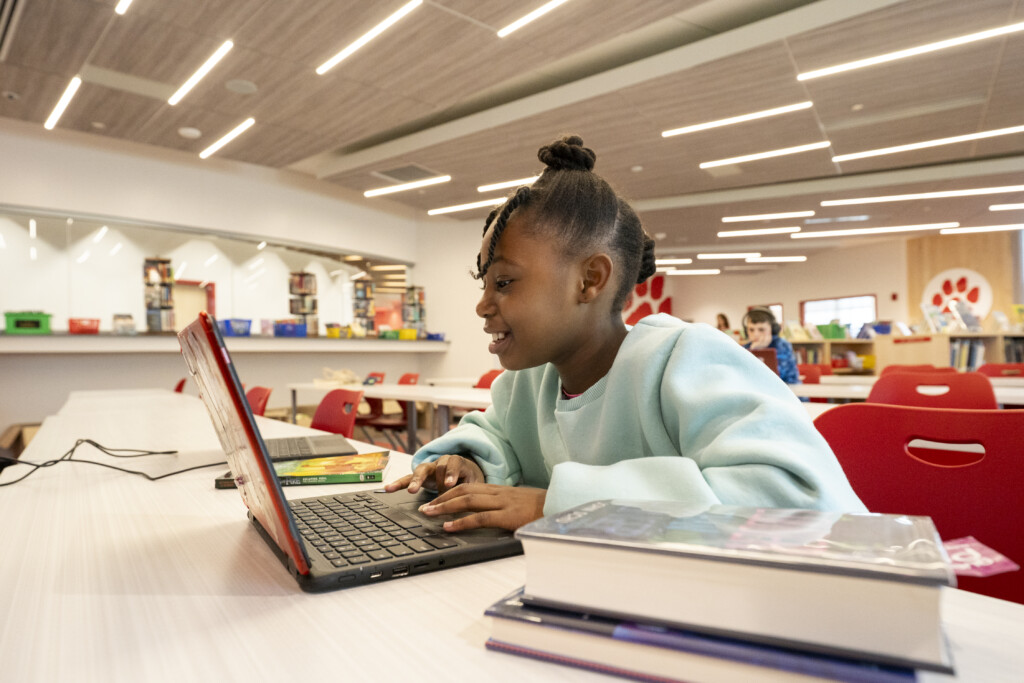By: Rae Lymer
In the rush to solve today’s education challenges with AI and technology, we risk asking the wrong question.
As conversations about AI and technology dominate national discourse, especially in education, there’s a growing push to use tech as a fix for systemic issues like teacher shortages, burnout, and limited instructional time. Faced with mounting pressures, it’s understandable that leaders might turn to technology as a replacement for human capacity.
But that’s a short-sighted solution.
Rather than asking how technology can replace teachers, or make their existing jobs more streamlined, we must ask: how can technology enable educators to spend more time with more students in deeper, more meaningful ways? The real opportunity is not in substituting teachers or focusing on efficiency. Instead, it’s about rethinking the ways that we support educators in building meaningful connections with students.
At FullScale (formerly known as The Learning Accelerator), we have found that effective learning, whether in person or online, depends far more on relationships than on digital tools. Across our recent studies, both educators and students have consistently described how deep connections and relationships makes teaching and learning more valuable. These findings suggest that the most powerful learning models are those that use technology to enhance human connection, not diminish it.
Teachers – Not Tools – Make the Difference
Through our Exponential Learning Initiative, we partnered with six virtual and hybrid schools to understand what helped students thrive in tech-enabled environments. In our fall surveys, students were asked to identify what they felt contributed the most to their success.
It wasn’t the tools. It was the teachers.
Students shared stories about educators who checked in after a tough week, adapted lessons based on their needs, or simply made them feel seen and supported. These small, everyday interactions helped students stay motivated and connected – feelings often not associated with virtual instruction.
As a result of these relationships, teachers could more effectively personalize instruction and create more space for learner agency. Students also emphasized the importance of having these choices in their learning, and reported that when they were given the opportunity to shape how, when, and what they learned, they felt more invested. This sense of agency helped them take ownership and stay engaged, even in challenging circumstances.
Educators echoed these themes, recognizing that knowing their students personally and building relationships was key to supporting their progress. While they used digital tools to structure and streamline learning, it was the human connections that made the real difference–whether they be through giving feedback, offering flexibility, or responding with care,.
Similarly, with a different project, we conducted an international survey with 1,700 educators to understand how they defined success and what contributed to it. Again, connections with students and colleagues emerged as critical.
These findings point in the same direction: technology is most powerful when it supports–rather than replaces–relationships, personalization, and connection. When learning models are designed well, tools fade into the background, allowing human-centered learning to come to the forefront.

Technology should enhance human connection, not reduce it.
For many schools, adopting edtech is a response to real resource constraints. With fewer staff and limited time, tools can offer relief, making it easier to manage workloads, monitor progress, and increase efficiency. Technology can and should be a part of the answer, but efficiency should not come at the expense of effectiveness.
When technology is used primarily to automate or replace elements of teaching, it can erode the very relationships that make learning meaningful. A tool might make instruction easier to deliver, but if it disconnects students from teachers, it risks weakening engagement and students’ potential growth.
In our work with the School Teams AI Collaborative, we’ve seen how the right tools can create opportunities for one-on-one check-ins, allow for timely and personalized feedback, and support more flexible learning experiences that reflect individual student needs. When technology is thoughtfully integrated to amplify relationships and student voice, it enables high-quality learning experiences where students thrive.
A People-First Vision for the Future
As schools design and refine their learning models, one principle must stay at the center: people matter most.
When we evaluate technology, the core questions shouldn’t be “Does it save time?” or “Can it scale?” but rather:
- “Does it strengthen student-teacher relationships?”
- “Does it elevate student voice and agency?”
- “Does it enable more meaningful learning?”
If the answer is yes, then technology becomes a powerful tool for engagement, efficiency, and enabling deeper learning. This is the moment to get it right. By listening to what students and educators tell us they need, and by using technology to empower, not replace, we can pathways for high-quality learning to flourish.
Rae Lymer is a Partner, Research, Measurement, & Policy at FullScale.
The post Designing Learning Models that Put People First appeared first on Getting Smart.